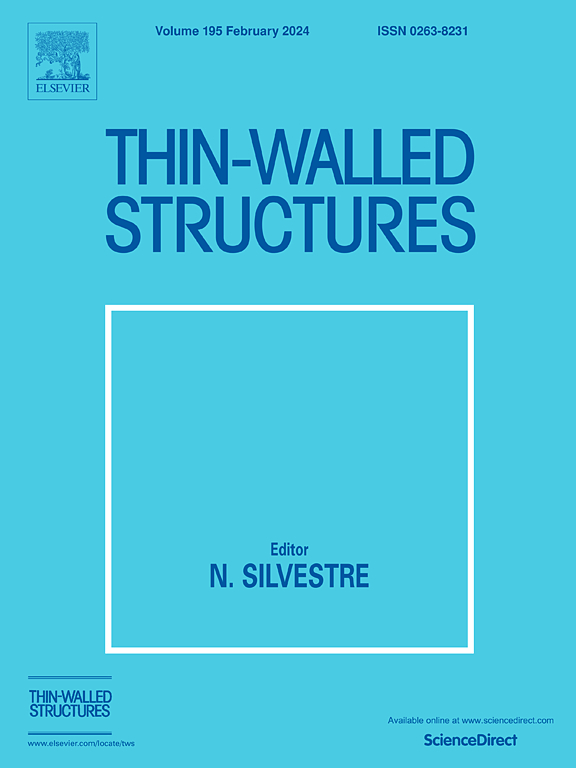Microstructure and material properties of 3D-printed bimetallic steels
IF 5.7
1区 工程技术
Q1 ENGINEERING, CIVIL
引用次数: 0
Abstract
Corroded steel components can be repaired by laser 3D printing technology. However, studies on the mechanical behaviour of repaired areas composed of a substrate and deposited material are still limited. In this study, 316 L stainless steel powder was deposited on Q355B steel plates through 3D laser printing technology to form bimetallic steel plates. Uniaxial tensile tests were conducted on Q355B steel coupons, laser 3D-printed 316 L stainless steel coupons, and bimetallic steel coupons. The test results revealed that ductile fracture occurred in the bimetallic steel coupons. The mechanical properties of bimetallic steel are considerably correlated with the properties of the cladding layer and substrate. During the loading process, the axial strain of the bimetallic steel coupons was uniformly distributed along the thickness direction, indicating that the substrate and cladding materials maintained excellent cooperative deformation. Bending tests and scanning electron microscopy observations indicate that a reliable and robust metallurgical bond is established at the interface between the substrate and the cladding layer. The interface area can be divided into the cladding layer, the carburising zone, the decarburised zone, and the Q355B substrate. The microhardness results indicate a considerable increase in the hardness of the carburised layer, which enhances the tensile strength of the bimetallic steel. On the basis of the experimental results, a three-stage model for predicting the stress‒strain curve of bimetallic steel was established.
三维打印双金属钢的微观结构和材料特性
腐蚀的钢部件可以通过激光三维打印技术进行修复。然而,由基底和沉积材料组成的修复区域的机械性能研究仍然有限。本研究通过三维激光打印技术在 Q355B 钢板上沉积 316 L 不锈钢粉末,形成双金属钢板。对 Q355B 钢板、激光三维打印的 316 L 不锈钢钢板和双金属钢板进行了单轴拉伸试验。试验结果表明,双金属钢片发生了韧性断裂。双金属钢的力学性能与覆层和基体的性能密切相关。在加载过程中,双金属钢试样的轴向应变沿厚度方向均匀分布,表明基体和覆层材料保持了良好的协同变形。弯曲试验和扫描电子显微镜观察结果表明,在基体和包层之间的界面上建立了可靠而牢固的冶金结合。界面区域可分为堆焊层、渗碳区、脱碳区和 Q355B 基体。显微硬度结果表明,渗碳层的硬度显著提高,从而增强了双金属钢的抗拉强度。在实验结果的基础上,建立了预测双金属钢应力-应变曲线的三阶段模型。
本文章由计算机程序翻译,如有差异,请以英文原文为准。
求助全文
约1分钟内获得全文
求助全文
来源期刊

Thin-Walled Structures
工程技术-工程:土木
CiteScore
9.60
自引率
20.30%
发文量
801
审稿时长
66 days
期刊介绍:
Thin-walled structures comprises an important and growing proportion of engineering construction with areas of application becoming increasingly diverse, ranging from aircraft, bridges, ships and oil rigs to storage vessels, industrial buildings and warehouses.
Many factors, including cost and weight economy, new materials and processes and the growth of powerful methods of analysis have contributed to this growth, and led to the need for a journal which concentrates specifically on structures in which problems arise due to the thinness of the walls. This field includes cold– formed sections, plate and shell structures, reinforced plastics structures and aluminium structures, and is of importance in many branches of engineering.
The primary criterion for consideration of papers in Thin–Walled Structures is that they must be concerned with thin–walled structures or the basic problems inherent in thin–walled structures. Provided this criterion is satisfied no restriction is placed on the type of construction, material or field of application. Papers on theory, experiment, design, etc., are published and it is expected that many papers will contain aspects of all three.
 求助内容:
求助内容: 应助结果提醒方式:
应助结果提醒方式:


